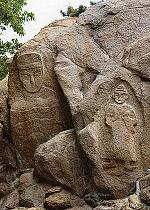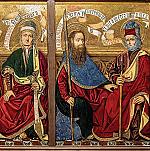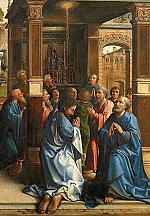“Doubting” or “daring” Thomas?

[ABOVE: Georges de La Tour, Saint Thomas, 1625 to 1630. Oil on Canvas—Louvre Museum / Public doman, Wikimedia]
Nobody likes to be remembered for their mistakes or be defined by their failures. Yet Jesus’s disciple Thomas suffered exactly that fate. Everyone knows him as the doubter who refused to believe that the Savior had risen from the dead. Thomas famously declared, “Unless I see the nail marks in his hands and put my finger where the nails were, and put my hand into his side, I will not believe” (John 20:25).
Ever since Thomas uttered his dubious dictum, he has been scorned as unfaithful. Throughout art history—whether on an ancient Roman coffin, a Byzantine icon, or a Renaissance altarpiece—the image of Thomas probing the wounds of Christ has served to highlight his wavering faith. Caravaggio’s renowned painting, The Incredulity of Saint Thomas (c. 1602) portrays the disciple’s probing of his Lord’s gashed side with such intimacy and gritty realism that Thomas seems to be performing a crude autopsy.
But does Thomas deserve to be remembered only as a doubter? After all he was the lone disciple who was willing to risk danger when Jesus faced mob violence. “Let us also go,” he urged the other disciples, “that we may die with him” (John 11:16). And if his courage in the face of death isn’t sufficient proof of his faith, let’s also remember his foundational acceptance of Jesus’s deity in his acclamation, “My Lord and my God!” (John 20:28). The truth is Thomas had more faith than he’s often given credit for. He was actually quite daring!
MISSION TO THE EAST
Once Thomas got past his temporary doubt and recovered his faith, he became a bold missionary for his risen Lord. How do we know this, since it isn’t recorded in Scripture? Evidence strongly suggests that Thomas traveled eastward from Jerusalem with the gospel after Jesus returned to heaven. He may even have reached India. Where do we learn about this?
The ancient Christians loved the biblical Acts of the Apostles so much that they produced many subsequent imitations. Modern scholars call these writings “apocryphal acts” because they’re all in the same genre but aren’t part of the New Testament canon (see pp. 14–16). Just because these texts aren’t divinely inspired doesn’t mean they can’t contain nuggets of truth. When the layers of frivolous folklore and deviant doctrine are peeled away, historical kernels often remain, especially when a given data point can be corroborated by other lines of evidence.
Sometime in the early third century, the church’s oral traditions about Thomas came to be written down in a Syriac text called the Acts of the Holy Apostle Thomas. Shortly afterward it received a Greek translation and became popular among speakers of that language. Interrelated versions of the Acts of Thomas proliferated in the Syrian and Mesopotamian contexts as different scribes and editors—many of whom were less than orthodox in their theology—applied their creative powers to the text. Although this resulted in some confused remembrances and unlikely elaborations, the basic storyline remained intact—and deep inside it, we might be able to catch an actual glimpse of Thomas himself.
TIMID THOMAS
The story recounts 13 distinct episodes in Thomas’s ministry, culminating in his martyrdom. At the beginning of the narrative, all the disciples are gathered in Jerusalem, where they draw lots to determine which lands they should evangelize. When Thomas’s lot falls to India, he declines the assignment because his body is too weak for travel. He asks, “How can I, who am a Hebrew, go and preach the truth among the Indians?” Even after Jesus appears to him with the promise of assisting grace, Thomas refuses to go where he has been called. “Send me where thou wilt—but somewhere else! For I am not going to the Indians,” he stubbornly declares. Surely he is a notorious doubter!
But Jesus is more clever than Thomas is timid. An Indian merchant named Abban has traveled to Jerusalem at the behest of his king, Gundaphorus. Abban has been instructed to buy a slave to serve as a carpenter for the royal palace. The resurrected Jesus spots Abban in the marketplace and approaches him with a proposition. He sells him Thomas as the needed slave, even providing a bill of sale for his (supposed) twin brother. At last Thomas can only declare, “I go wither thou wilt, Lord Jesus; thy will be done!” Abban takes his new slave back to King Gundaphorus. In this way Thomas finds himself in India, where he embarks on a series of evangelistic escapades and marvelous miracles. His bold witness for the gospel makes many joyful converts—but also some deadly enemies.
After many years of courageous ministry, a different king orders Thomas’s execution by spearing. The soldiers dutifully run him through. Even after his death, Thomas’s faith is confirmed when the king tries to exorcise a stubborn demon from his son by putting the boy in contact with the saint’s relics. Although Thomas’s bones have been removed to the West, enough sanctified dust remains in the former grave to cast out the demon. The grateful king believes in Jesus, proving that Thomas’s powerful ministry continues beyond the grave, just as it does through the Savior himself.
PLAUSIBLE PROOFS
Though the Acts of Thomas contains many legends and a false spirituality in its overly ascetic bent, it also makes some plausible historical claims. The king whom Thomas served, Gundaphorus, can be associated with an actual first-century ruler in the Indus River area, Gondophares IV, who controlled the Parthian territory in what is today Pakistan and India. Likewise the ancient church historian Eusebius recorded a statement by Origen that “Parthia, according to tradition, was allotted to Thomas as his field of labor.” Certainly it would have been possible in those days for a Judean traveler to reach India, either overland via the trade route called the Silk Road, or by water from the Red Sea into the Indian Ocean. Numerous Roman coins have been found along India’s western coast, proving that a lively commercial exchange existed between the two lands.
The statement that Thomas’s bones couldn’t be found by a later king has also attracted scholarly interest. The Acts of Thomas claims that an unknown Christian had taken them back to “the West.” In antiquity Thomas’s tomb and relics were believed to reside at Edessa, a city in the borderlands between the Parthian and Roman Empires. The great poet of Edessa, Ephrem the Syrian (c. 306–373), wrote a hymn in which the devil laments, “The apostle whom I slew in India is before me in Edessa!” A few years later, the Spanish nun Egeria passed through Edessa during a pilgrimage from 381 to 384 and prayed at Thomas’s tomb where his relics lay at rest. She described the shrine as “very great, very beautiful and of new construction, well worthy to be the house of God.” Today the most important bone of Thomas’s holy skeleton—the supposed finger that probed the wounds of Christ—can be seen behind glass in Rome’s Basilica of Santa Croce in Gerusalemme.
TO THE ENDS OF INDIA
Did the apostle Thomas actually found the Indian church? At the very least, it’s possible that he traveled on the Silk Road through Edessa to evangelize the northern Indian lands of King Gondophares. The modern Saint Thomas Christians (such as the Mar Thoma [St. Thomas] Church, along with other ancient denominations) also claim his presence in the south of India, along the Malabar Coast in the state of Kerala. While that is more doubtful, enough international trade existed with the Roman Empire to leave it within the realm of possibility. Yet because the records of an apostolic visit rely on sacred songs and texts preserved through centuries of oral tradition, historians can’t be sure that Thomas ever visited that southern region.
Nevertheless the history of Christianity in Kerala is very old. Eusebius records that a second-century scholar named Pantaenus traveled from Egypt to India and found Christians already worshiping there and reading the Gospel of Matthew. Zealous missionaries had followed the apostolic model of overseas evangelism. The roots of the Indian church may go back to a first-century foundation, even if Thomas himself never made it there.
All of this journeying, evangelizing, miracle-working, and maybe even dying by a spear thrust doesn’t sound like the work of a “doubter.” For any Judean man to travel as far as Edessa would have been a major undertaking—much less all the way to India! If Thomas achieved even a small part of what is attributed to him, he was a brave man. Perhaps it’s time to retire his unfortunate nickname. Though he did experience a moment of doubt, he didn’t remain locked in unbelief. According to the best evidence we have, his encounter with the risen Christ launched him on an evangelistic mission to the East. History’s most famous doubter should be rechristened with the much better name of Daring Thomas! CH
By Bryan M. Litfin
[Christian History originally published this article in Christian History Issue #156 in 2025]
Bryan M. Litfin is professor of Bible and theology in the Rawlings School of Divinity at Liberty University and the author of After Acts: Exploring the Lives and Legends of the Apostles.Next articles
Courage, zeal, and faithfulness
Accounts of Judas Thaddeus, Simon the Zealot, and Matthias help explain the Gospel’s far reach
Rex D. ButlerSupport us
Christian History Institute (CHI) is a non-profit Pennsylvania corporation founded in 1982. Your donations support the continuation of this ministry
Donate







